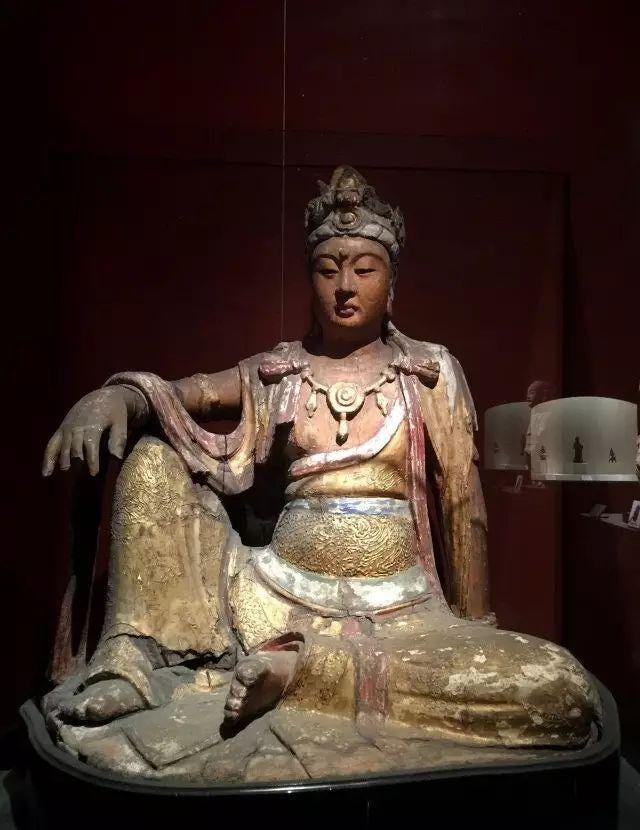Nudity in Chinese Art: Why Is It Rare?
Analyzing East-West Differences in Representations of the Human Body in Art
Expression of the week: 裸体艺术 (luǒ tǐ yì shù)
Meaning: nude art
相对于西方艺术中丰富多样的裸体艺术来说,中国古代的人体表现形式相对较少。Compared to the diverse and abundant expressions of nudity in Western art, representations of the human form in ancient Chinese art were relatively fewer and often more restrained.
When walking into a Chinese art museum, the difference in artistic expression between Chinese and Western art is clearly visible. However, one aspect strikes in particular: the lack of nude art in China. In comparison to Greco-Roman artists, their Chinese equivalents rarely ever engaged in depicting a naked human body. Why is that?

早期的人类在洞穴壁画中就开始描绘人体形象,这些图像通常以简洁的线条勾勒出人体的轮廓,表达着对人类形象的崇敬和神秘感。这些早期的艺术作品揭示了人类对于人体的关注和探索。随着文明的发展,人体艺术逐渐成为古代文化的一部分。在古希腊和古罗马文化中,人体艺术得到了独特的发展和表达。
壁画 (bì huà) - mural
描绘 (miáo huì) - depict
简洁 (jiǎn jié) - simple, concise
线条 (xiàn tiáo) - lines
勾勒 (gōu lè) - outline
轮廓 (lún kuò) - contour
崇敬 (chóng jìng) - reverence
神秘感 (shén mì gǎn) - sense of mystery
揭示 (jiē shì) - reveal
探索 (tàn suǒ) - exploration
Early humans began depicting human figures in cave paintings, often using simple lines to outline the contours of the body, expressing reverence and a sense of mystery toward the human form. These early artworks reveal humanity's focus on and exploration of the human body. With the development of civilization, body art gradually became an integral part of ancient cultures. In Greek and Roman culture, body art achieved unique development and expression.
古希腊文化赋予人体以美的意义,将其视为神圣的创造物。古希腊的雕塑艺术以裸体男性和女性形象为主题,追求人体的比例、线条和动态之美。这些艺术作品成为了西方人体艺术的重要基石,也影响了后来的艺术发展。
赋予 (fù yǔ) - endow, imbue
神圣 (shén shèng) - sacred
创造物 (chuàng zào wù) - creation
雕塑 (diāo sù) - sculpture
裸体 (luǒ tǐ) - nudity
形象 (xíng xiàng) - image, figure
主题 (zhǔ tí) - theme
比例 (bǐ lì) - proportion
动态 (dòng tài) - dynamics
基石 (jī shí) - cornerstone
Ancient Greek culture imbued the human body with the significance of beauty, viewing it as a sacred creation. Greek sculpture often focused on nude male and female figures, striving to capture the beauty of human proportions, lines, and dynamics. These works became a cornerstone of Western body art and profoundly influenced subsequent artistic development.

中国古代虽然没有人体艺术,但这并不意味着中国古代没有关注人体形象。
中国古代绘画和雕塑更注重表达内涵和情感,注重形象的含蓄和象征性的表达。人体形象在中国传统艺术中更多地被用来表达意境、道德和文化的含义,而不是单纯追求形态和比例之美。中国古代绘画中的人物形象常常通过服饰、姿态、面部表情等来传递信息和情感,强调内在的精神和情绪的表达。
含蓄 (hán xù) - subtle, implicit
象征性 (xiàng zhēng xìng) - symbolic
意境 (yì jìng) - artistic conception
单纯 (dān chún) - purely
形态 (xíng tài) - form
服饰 (fú shì) - clothing, attire
姿态 (zī tài) - posture
面部表情 (miàn bù biǎo qíng) - facial expression
传递 (chuán dì) - convey
精神 (jīng shén) - spirit, essence
情绪 (qíng xù) - emotion
Although ancient China did not have body art in the traditional sense, this does not mean that there was no attention to the human form in ancient Chinese culture.
Ancient Chinese painting and sculpture focused more on conveying meaning and emotion, emphasizing subtlety and symbolic expression. The human figure in traditional Chinese art was often used to convey artistic conception, moral values, and cultural significance, rather than simply pursuing the beauty of form and proportion. In Chinese paintings, human figures often conveyed messages and emotions through clothing, posture, and facial expressions, highlighting the expression of inner spirit and emotion.

在雕塑艺术中,中国古代更注重的是以神话、佛教和儒家思想为主题,强强调人物的象征性和精神内涵,而不是对人体形态的直接描绘。例如,中国古代石刻中的佛像和石像常常通过丰富的装饰,以及抽象的姿态来表达宗教信仰和道德价值,而不是追求人体的真实再现。
精神内涵 (jīng shén nèi hán) - spiritual essence
直接描绘 (zhí jiē miáo huì) - direct depiction
石刻 (shí kè) - stone carving
佛像 (fó xiàng) - Buddha statue
石像 (shí xiàng) - stone statue
装饰 (zhuāng shì) - decoration
抽象 (chōu xiàng) - abstract
宗教信仰 (zōng jiào xìn yǎng) - religious belief
道德价值 (dào dé jià zhí) - moral values
真实再现 (zhēn shí zài xiàn) - realistic reproduction
In sculptural art, ancient China placed greater emphasis on themes rooted in mythology, Buddhism, and Confucian thought, focusing on the symbolic and spiritual essence of figures rather than direct depictions of the human form. For example, ancient Chinese stone carvings, such as Buddha statues and stone figures, often used intricate decorations and abstract poses to express religious beliefs and moral values, rather than striving for a realistic representation of the human body.
中国古代文化中的儒家思想,也对人体艺术的发展产生了影响。
儒家强调社会秩序、道德规范和人际关系的和谐,对于个体的内敛和自我克制有着重要的强调。在这样的文化背景下,裸体被视为私密和隐私的象征,对于裸体的展示持较为保守的态度。因此,中国古代艺术中较少有直接描绘裸体的作品。
社会秩序 (shè huì zhì xù) - social order
道德规范 (dào dé guī fàn) - moral standards
人际关系 (rén jì guān xì) - interpersonal relationships
和谐 (hé xié) - harmony
内敛 (nèi liǎn) - reserved, introverted
自我克制 (zì wǒ kè zhì) - self-restraint
私密 (sī mì) - private, intimate
隐私 (yǐn sī) - privacy
Confucian thought in ancient Chinese culture also influenced the development of body art.
Confucianism emphasized social order, moral principles, and the harmony of interpersonal relationships, placing significant importance on modesty and self-restraint. Within this cultural context, nudity was regarded as a symbol of privacy and intimacy, and a conservative attitude was adopted toward its display. As a result, direct depictions of nudity were relatively rare in ancient Chinese art.
但需要指出的是,中国古代并不完全没有人体艺术的表现形式。在一些绘画、雕塑和壁画中,仍然可以找到一些对人体形象的描绘。然而,相对于西方艺术中丰富多样的裸体艺术来说,中国古代的人体表现形式相对较少。
相对于 (xiāng duì yú) - in comparison to
丰富多样 (fēng fù duō yàng) - rich and diverse
裸体艺术 (luǒ tǐ yì shù) - nude art
相对 (xiāng duì) - relatively
It is important to note, however, that ancient China was not entirely devoid of representations of the human form. Some paintings, sculptures, and murals do feature depictions of human figures. However, compared to the diverse and abundant expressions of nudity in Western art, representations of the human form in ancient Chinese art were relatively fewer and often more restrained.
Have you ever wondered why was it the case?
Antoine & Dorota
Referenced author(s): 千秋文化







